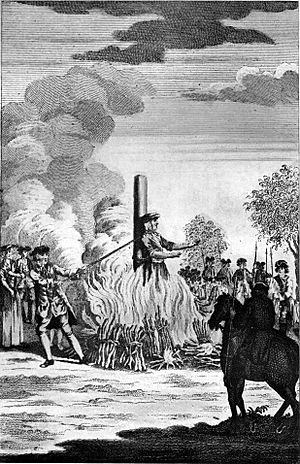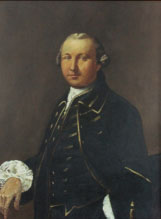Burning of women in England facts for kids
For many centuries in England, a very harsh punishment for women found guilty of certain serious crimes was execution by burning. This was especially true for crimes like betraying the country, or having religious beliefs that were different from the official church. These executions often happened in public.
However, by the late 1700s, people started to think differently about showing such severe punishments in public. A man named Sir Benjamin Hammett, who was a member of Parliament, spoke out strongly against this practice. He introduced a proposed law to stop it. This wasn't the first time someone tried to end the public burning of women, but his efforts led to the Treason Act 1790. This important law finally put an end to this type of punishment.
Contents
A Harsh Punishment in History
In the past, laws were very different from today. For a long time in England, women who committed certain serious offenses could be sentenced to death by burning. This was a legal punishment, meaning it was allowed by the laws of the time.
Why Was This Punishment Used?
This extreme punishment was used for specific types of crimes. These included:
- Treason: This meant betraying the king, queen, or the country. There were different levels of treason, but all were considered very serious.
- Heresy: This referred to having religious beliefs that were different from the official church teachings of the time. In some periods, this was seen as a major crime.
- Other Serious Crimes: Sometimes, it was also used for crimes like making fake money or even for a wife killing her husband. These acts were seen as breaking important social rules or laws.
These punishments were often carried out in public places. This was meant to be a warning to others not to commit similar crimes.
How Did Attitudes Change?
Over time, people's ideas about justice and punishment began to evolve. By the 1700s, many started to feel uncomfortable with the public display of such brutal executions. They believed it was too cruel and not necessary.
One important person who worked to change this was Sir Benjamin Hammett. He was a Member of Parliament, which means he was part of the government that made laws. He felt strongly that the practice of burning women should stop.
The End of Public Burnings
Sir Benjamin Hammett spoke out in Parliament against these public burnings. He introduced a new law, called a "bill," to try and abolish, or end, this punishment. While others had tried before him, his efforts were successful.
In 1790, the Treason Act 1790 was passed. This law officially ended the practice of burning women as a form of punishment in England. It was a significant step forward in making laws more humane and less cruel. This change showed that society was moving towards more modern and less brutal ways of dealing with crime.
Images for kids
-
Woodcut of the burning of Anne Askew, for heresy, at Smithfield in 1546





